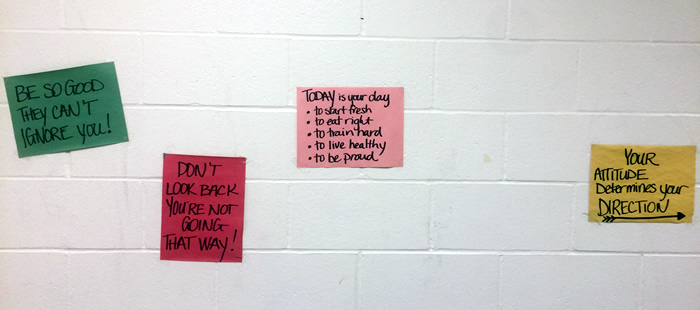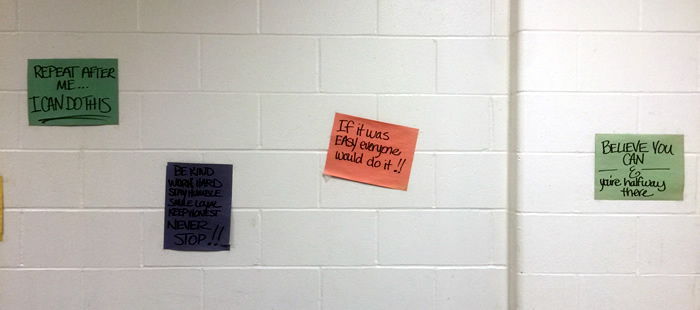Monday, February 8, 2016
IN THIS ISSUE:
Developing a Young Mallet Player | Preparing Your Beginners
Developing a Young Mallet Player
by Nick Fernandez
Editor's Note: The article was re-printed here with permission of the author. Click here for the original source material.
A student's first year in band or orchestra is arguably the most influential and critical time in their musical life. Rather than teaching a beginning student all of the things they need in music, I tend to take the approach of teaching a small number of concepts and focusing on preventing the development of bad habits.

Technique
We can all agree that starting a bad habit at a young age is very easy to do, however breaking that habit down the road is exponentially more difficult! With beginning mallet students, I use the practice pad to develop technique in the hands, as the keyboard is largely used to develop the musical mind. We simply transfer our basic "piston stroke" over from the pad to the bells with the understanding that the bells are not providing rebound. Further instruction on keyboard tone quality is delayed until the second year of instruction when we are able to play on a variety of keyboards, rather than just beginner bell kits.
Through years of being a "struggling" mallet player, I have developed a teaching strategy that has yielded positive results in a short time. When learning a mallet piece at a young age, I would spend ten minutes on just one measure to make sure I was playing all the right pitches. Talk about inefficiency, not to mention sight reading skills in the basement! I have absolutely used my personal struggle to help my students not fall into the same trap and the new strategy has done wonders for my own playing, even at a more mature age.
Gamification
With beginning mallet players the first step is internalizing what notes correspond to the lines and spaces on the staff. Luckily, most of my students have been exposed to this in their general music class before they get to me. The next step is to know where all of these notes are on their keyboards. This one can take a while. One of the best tools for this is a speed note reading game such as this free one online. When youngsters play a game, they are SO much more willing and excited to learn. It is during this time of finding notes on the keyboards that half steps and whole steps are introduced. I find this concept to be very important to the next steps.
Early Reading and Avoiding the Sun
Once we can find our notes on the keyboard fairly well, we start the reading process. The first thing we do when "reading" is count the rhythm out loud. Next, we say the names of the notes (in rhythm) and touch the note as we say it. This step is the most crucial step in my opinion. This is where the connection between the music and the keyboard happens, which is where I always derailed as a young musician. We will repeat this step until everyone is comfortable and feels successful, and then we play!
While the students play, I am on high alert in search of the beginnings of bad habits, the biggest culprit being looking down at the keyboard! One of my favorite analogies is telling students to treat the keyboard like the sun. You can glance at it, but if you look for longer than a glance, you'll go blind!
Now, the big issue with fighting this habit is that students are also developing technique at this time which increases their note accuracy. So when a student hears a wrong note, they instantly want to look down instead of understanding that it is likely just an accuracy issue that will get dialed in over time. My students start on bells, which is difficult for even experienced players to be accurate on, so I stress that missing a pitch on the bell kit is an acceptable mistake, whereas missing a rhythm is not. Most method books do a good job of starting with one or two notes and expanding the reading range little by little, which is helpful in building accuracy.
Scales
Before we start introducing the concept of key signatures, I introduce scales. I have really come to embrace the power of scales. The better students know and understand them, the more dangerous they become as musicians. I have tried several different approaches when teaching scales; here's what I like at the moment: learning scales without music.
I understand the irony. Scales are the one thing that I would like my students to have memorized. Most other instruments have some sort of tactile reference in playing a scale, whereas on a keyboard instrument all of the notes "feel" the same when you play them. For this reason, I find it VERY difficult to play scales on a keyboard without looking down and my students are taught that they may look at the keyboard ONLY while playing scales.
So, we learn them in patterns. First the wwhwwwh formula (whole steps and half steps), and then we "block" them out. Meaning, grouping the naturals and accidentals to see the pattern created (ie for Bb: 1,2,1,3,1).
We organize the scales in the circle of 5ths/4ths, or as my students deemed it, the "circle of life." This concept of understanding that all music is written in a series of scales and the circle is absolutely not above a beginning musician. I love seeing the "light bulb" moments when students begin to see all of the patterns that surround scales and the circle. Then with this understanding, when a key signature is present, the students know that all of the notes are just patterns in whatever scale is dictated.
That's All
This is all I teach a young mallet player for the first year; all major scales and reading as much as we can get to. The finesse and nuance of mallet technique is reserved for the second year of instruction. Teaching finesse on a bell kit is a pretty tall order and it's hard enough to hit those tiny keys as a 6th grader!
 |
Nick Fernandez Nick Fernandez is the director of percussion at Bentonville Public Schools in Bentonville, Arkansas, where he teaches percussion students from 6th grade through 12th. Previously, Nick served as the director of percussion at Owasso Public Schools in Owasso, OK. He has performed with the Colts Drum and Bugle Corps, the North Arkansas Symphony Orchestra, Tulsa Signature Symphony, and various local bands in the Tulsa and Northwest Arkansas areas. |
Getting Your Beginners Ready and Rarin' to Go!
by Bridgett Randolph
'Tis the season to begin thinking about your next crop of beginners! Those little kids who are so excited to finally get to try something new and exciting in school! How do you go about getting them excited and wanting to become a part of your program? You recruit! Recruiting your beginners is a year-round activity. Anytime that you can promote your program to young students go for it. I'm talking from Pre-K throughout elementary school. Anytime that you have an opportunity to highlight your program, do it! Have your band march through the hallways of the school on football game days..leading everyone into the pep assembly. Have your orchestra play as students are entering the building; anything so that you are visible throughout the school year. When it is time to get the students signed up for band or orchestra, talk and test every single student in the upcoming class. Someone who says that they aren't interested may just become interested when they see all of their friends doing it and also when they have success on an instrument.
 Testing your students- I believe that sometimes we hurry students through this process a little. This is a very big decision that they are getting ready to make and we need to be thorough with our process so that the kids will not always be wondering if something else would have been better. Do a listening test with the students, one that will determine which instruments' sound they like the best. Do they like high sounds, middle, or low? Someone who is bound and determined to play the flute (because they like the way it looks) will not have success on the instrument if they actually prefer low sounds. When you play excerpts for them, let it be audio only. This way they will not be distracted by the visual aspect of the performance. Next, have an informational card where the student writes down their initial interests but that also has each instrument listed so that you (or any friends that you recruit to help you) can write down notes about how the students did when they tried those instruments. It is very valuable to know that a student who is trying out a brass instrument was able to match pitch and play two or three partials. Sometimes you may need to write notes about the student's physical features and how they relate to the instrument. Always make your comments positive. You do not want kids that you are trying to recruit to feel bad about your program or themselves in any way!
Testing your students- I believe that sometimes we hurry students through this process a little. This is a very big decision that they are getting ready to make and we need to be thorough with our process so that the kids will not always be wondering if something else would have been better. Do a listening test with the students, one that will determine which instruments' sound they like the best. Do they like high sounds, middle, or low? Someone who is bound and determined to play the flute (because they like the way it looks) will not have success on the instrument if they actually prefer low sounds. When you play excerpts for them, let it be audio only. This way they will not be distracted by the visual aspect of the performance. Next, have an informational card where the student writes down their initial interests but that also has each instrument listed so that you (or any friends that you recruit to help you) can write down notes about how the students did when they tried those instruments. It is very valuable to know that a student who is trying out a brass instrument was able to match pitch and play two or three partials. Sometimes you may need to write notes about the student's physical features and how they relate to the instrument. Always make your comments positive. You do not want kids that you are trying to recruit to feel bad about your program or themselves in any way!
If you will be the only person testing the students, think about your logistics. I believe that it is much better to have the students sit in a big circle and then you go around to each one of them than to have them get in a line and come up to you. The reason for this is classroom management. The kids who are waiting for their turn will get antsy (and who can blame them they are getting ready to try out a really cool instrument) and that leads to discipline problems. If they have to sit in a circle, you can still watch all of them. Don't forget to sanitize the instruments in between everyone! For sax and clarinet I recommend using two mouthpiece setups so that one can soak in sanitizer while you are using the other.
After you have completed all of the testing, it is time for you to sit down and decide who will play what. Make sure that you have a good instrumentation! It has been my experience that most students will be able to get their first or second choice and you can still have great instrumentation! Once your list is complete mail and email a letter home to the parents that inform them of what the child's choices were and what your recommendation is based on their test results. Let the parents know that the student preferred to hear low sounds. Let them know what they tested really well on. If they have questions about your recommendation, they will contact you. Next, on that form, have a meeting time set so that you can then talk to the parents about your program and about obtaining an instrument. (Your Palen rep can help you with ALL of these processes and we even have sample letters for you!)
Getting their instruments- If you are lucky enough to teach your beginning instrumental classes in small, like-instrument classes then you can just set up an instrument night, (again your Palen rep will be happy to help you!) get those instruments, and get cracking the next day! If you teach everyone all together, it might be a good idea to have a clinic setup at the instrument night where, after everyone has received their instrument, the students and their parents go to different areas and learn the basics of how to assemble their instrument and how to care for it. They should do it three to five times with the help of the clinician. The parents should also do it. This helps you tremendously! The next day in class everyone will know how to put their instruments together. The trombones won't be left to their own devices as you are showing the clarinets how to put their reed on! I recommend setting the night up on a Thursday so that the kids will have a fantastic Friday in band and then they can take their instruments home over the weekend and their parents will still remember how to help them. Their weekend homework could be a video that they email you of them assembling their instrument with their parent or teaching their parents how to assemble the instrument and then make the first sounds.
 |
Bridgett Randolph Bridgett Randolph received her B.M.E. from Central Methodist University and her M.Ed. from William Woods University. She has taught instrumental music for the last 18 years with the latter 10 years in the Columbia Public Schools. Bridgett also taught high school and middle school at Orrick R-IX, Mid-Buchanan R-V, and Southern Boone R-I school districts. Bridgett is a member of MMEA, NAfME, MNEA, MBA, and Phi Beta Mu. Bridgett has performed with the Columbia Community Band, Columbia Civic Orchestra, Memories Dance Band, Capitol Kicks Dance Band, Ray Auburn Big Band, and Kerry Strayer Big Band. She is active as a clinician and adjudicator and enjoys playing in big bands and community ensembles so give her a call if you need a trombone player! Bridgett currently resides just outside of Columbia, MO with her husband Mark, and their two wonderful children Olivia and Logan. |
Pictures from the Classroom - Washington, MO
These are pictures Mike Steffen took in Washington HS a couple of months ago. These are signs posted throughout their band hallway. Parents put them up in the fall to pump the kids up.


Contact Your Local Palen Music Center Representative
Can we assist you with
anything? Please contact your local Palen Music Center school road
representative for all of your music education needs.

